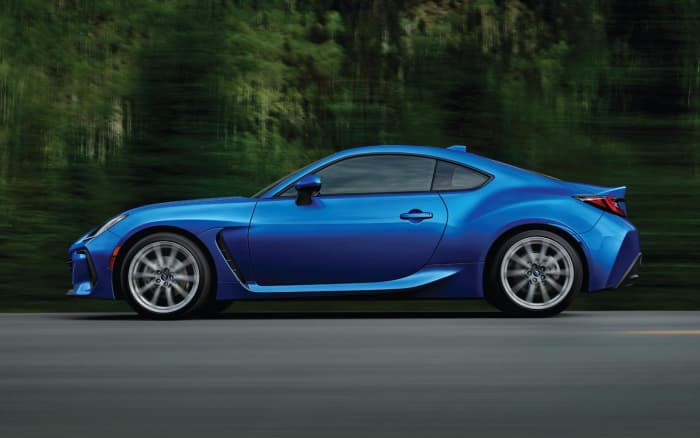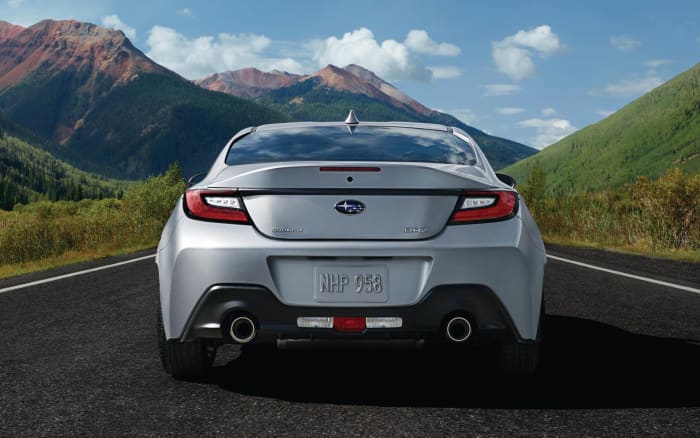This post was originally published on this site
Pros
- Stiffer chassis means more driving fun
- More powerful 2.4-liter engine
- Sleek new design
- Solid reputation for reliability
Cons
- Rear seat tight for adults
- Not as quick as some competitors
- No convertible model
- No adaptive cruise control with manual transmission
What’s new?
- All-new chassis with lower center of gravity
- Fresh 2.4-liter engine makes 15% more torque
- New digital gauge cluster
The rear-drive Subaru BRZ is all-new for the first time since it was launched for the 2013 model year. And it’s easy to see that this aggressively-styled sports car has been built for fun. This 2nd-generation 2022 BRZ is a “2+2” like before with two small rear seats that can be folded down to make room for cargo. And that cargo hold allows plenty of space to make the BRZ a practical daily driver.

The 2022 Subaru BRZ
Subaru
The BRZ’s main mission is to deliver a rewarding, fast-paced drive on a twisty road. And so much work has gone into improving the new chassis. And Subaru
FUJHY,
says this structure is 50% stiffer than the old one, which allows engineers to tune the MacPherson strut and multilink rear suspension systems to creates a more connected-to-the-road experience when the road curves. In fact, bending rigidity in the front structure alone is up by a whopping 60%, which Subaru says allowed them to make the steering more responsive.
Subaru developed an aluminum roof, front fenders, and hood for the new BRZ to help shave weight. And the result is an all-new car that is essentially no heavier than the old model, despite being slightly longer and packing more equipment. That’s a rare feat these days. And less weight generally means the car is more agile. In fact, Subaru says this is the lightest 2+2 sports car for sale in the U.S. at just under 2,900 pounds.
Under the BRZ’s long hood sits a larger 2.4-liter horizontally opposed “Boxer” 4-cylinder that develops 228 hp and 184 lb-ft of torque. That’s a modest increase in both horsepower and torque over the last BRZ. But the BRZ experience is less about drag racing and more about revving the engine to redline and pitching the car into a tight bend on a canyon road. Buyers have a choice of shifting themselves with a 6-speed manual or selecting a 6-speed automatic with paddle shifters and technology that will “blip” the throttle right before a downshift for a smoother experience.

The 2022 Subaru BRZ
Subaru
The BRZ’s stability control system is much more advanced than before and more in line with performance cars that cost a little more. The system now has five settings, including a Track mode, to tailor the amount of intervention to the driver’s skill set and the road conditions. For those that want to probe the limits of the BRZ without a safety net, the system can be completely turned off.
Quite a few cars in the BRZ’s competitive set like the Nissan
NSANY,
370Z, Chevrolet Camaro, and Ford
F,
Mustang pack more power and torque than the BRZ—even with the new model’s upgraded engine. Yet the BRZ is smaller, lighter, and provides a more nuanced driving experience. The one sports car that lines up most closely with the BRZ’s mission is the Mazda
MZDAY,
Miata, which also offers go-kart-like handling. However good as the Miata is on a twisty road, there’s precious little room inside the cabin or cargo hold. Translation? The BRZ is more practical.
2022 Subaru BRZ pricing
The 2022 Subaru BRZ starts at $27,995, which is about $1,000 less than the 2020 model (there was no 2021 Subaru BRZ). That’s the Manufacturer’s Suggested Retail Price (MSRP) of a 2022 Subaru BRZ Premium with a 6-speed manual transmission. When equipped with the automatic transmission, the 2022 BRZ Premium begins at $29,595.
As a Limited model, the 2022 Subaru BRZ starts at $30,495 with a manual transmission or $32,295 with the automatic.
For comparison, a 2021 Ford Mustang will run you $27,115, and a 2021 Mazda MX-5 Miata starts at just $26,830. Those are both good deals, but the 2021 Chevrolet Camaro begins way down at $25,000. That’s the steal of the bunch for a sporty car.
Subaru’s destination charge for the 2022 BRZ is $960 (or $1,110 in Alaska).
Driving the 2022 Subaru BRZ
If you liked Subaru’s first-generation BRZ sports car, you’ll love this all-new 2022.
It’s sharper-looking and boasts more power and torque from its larger, smoother-revving 2.4-liter direct-injected flat-4 “boxer” engine, improved handling, and a host of useful standard and available features. We drove both six-speed manual and automatic Limited-trim versions on some 2-lane roads and enjoyed multiple laps on Connecticut’s Lime Rock Park racetrack.
The added performance is immediately obvious with its 184 lb-ft of torque kicking in at lower revs, peaking at 3,700 rpm, and holding that level well beyond. You feel it in the car’s much-improved low-end throttle response, and it enables 0-60-mph performance of 6.0 seconds for the manual and 6.5 seconds for the automatic.
We also enjoyed the BRZ manual’s precise shifter and just-right clutch engagement, though we found it a bit difficult to “heel/toe” downshift, the technique that enables right-foot throttle blipping while braking. A Sport mode increases steering and throttle response, and holds gears longer with the automatic.
Thanks largely to a stiffer structure with strategic weight reductions, a lower center of gravity, improved suspension tuning, and the Limited’s 18-inch summer performance tires, the new BRZ’s on-track cornering prowess is impressive. It turns eagerly into corners, charges through them with impressive stability, and tracks out full throttle with authority. Its steering is quick, crisp, and responsive, and its braking is strong, sure, and linear. Only some loud tire noise on ragged surfaces somewhat diminished its on-road cruising enjoyment.
Inside the snug cockpit, new-design seats provide excellent support and retention during hard cornering along with good long-drive comfort for most occupants.
Interior comfort
It’s clear that Subaru designers pushed hard to make the BRZ’s interior more progressive. Its dimensions are about the same size as the old model, but the look and feel are much more modern. And part of that comes from the standard 8-inch infotainment system, which includes standard Apple
AAPL,
CarPlay and Android Auto.
But the centerpiece is the new digital gauge cluster. The 7-inch display screen in front of the driver replaces mechanical gauges. And that allows for a customizable cluster. The digital tach and speedometer are focused in the center, while a meter to the left can display units like amps, engine coolant temperature, or the G-forces the car can generate in a corner. Engage the Track mode, and the tachometer becomes a bar graphic—just like some race machines.
The BRZ is a 2+2, and that means the rear seats are small. They are certainly cramped for an adult compared to a sedan. But fold them down, and the Subaru can handle lots of stuff. You can remove the front wheel of a mountain bike and load it right in. Or, if you’d like to take your BRZ to the racetrack, you can carry along a full set of track tires.
Exterior styling
The BRZs new shape keeps some elements from the old car but blends the overall shape into a more cohesive and attractive package. Is it possible that the new BRZ’s design can be more aggressive, more refined, and more upscale at the same time? We think so. Those big air scoops on the sides of the nose funnel air to the brakes and the vents at the trailing edge of the front fenders are functional, helping to duct air out of both the wheelwells and underhood area. The BRZ’s roof is lower, and it’s narrower at the top to emphasize the car’s hips. We particularly like that ducktail rear spoiler flanked by the large diameter dual exhausts. Viewed from the outside, the new BRZ looks more expensive than it is.
Also see: Go topless: the 10 cheapest convertibles
Favorite features
Track mode
A car like this really benefits from a sophisticated stability control system. And the BRZ delivers with a specific Track mode setting for the stability and traction control that allows the driver to slide the car a bit before the system intervenes. But what’s neat about the BRZ is that its digital dash complements the mission by switching to a specific Track mode setting too.
Automatic transmission
Don’t get us wrong, manual transmissions are a great way to experience a car like this. But the BRZ’s upgraded automatic with sport mode (quicker shifts) and throttle blipping (to help match engine revs) makes this car more enjoyable as a daily driver.
Standard features
Even the base Subaru BRZ, the Premium, is thrilling to drive. New standard equipment on the Premium includes 17-inch alloy wheels, active engine sound tuning, and the Starlink infotainment system, which includes an 8-inch multimedia screen, Apple CarPlay/Android Auto, and Sirius XM radio. The 2022 BRZ Premium also gets a 7-inch digital instrument cluster, a driver’s knee airbag, and a rear center console with a storage box that features dual USB input ports and an auxiliary jack.
On the Limited, you get 18-inch alloy wheels (in a matte gray finish), grippy Michelin Pilot Sport 4 tires, active headlights, a blind-spot monitor, and synthetic suede upholstery with leather side bolsters and red stitching.
Factory options
On the BRZ Premium and BRZ Limited, the options are the same.
They include the 6-speed automatic transmission with paddle shifters, which means your BRZ also will be equipped with EyeSight Driver Assist technology that includes adaptive cruise control, a pre-collision braking system, and a lane-departure warning. Also available: automatic high-beam headlights and automatic emergency braking.
See: How to custom-order a car from the factory
Engine and transmission
The Subaru BRZ comes with just one engine. The new 2.4-liter horizontally-opposed “Boxer” flat 4-cylinder is similar to the engine used in Subaru’s large Ascent 3-row SUV. But here, the engineers left the turbocharger behind and modified the engine internals to deliver more power without boost. The result is a solid 228 horsepower at 7,000 rpm and 184 lb-ft of torque at 3,700 rpm. That’s 23 more horsepower and 28 more lb-ft of torque than the outgoing BRZ’s 2.0-liter. This new engine delivers its torque peak way lower in the rev range too, which should translate into easier cruising for the daily drive.
You might like: An ‘everyday sports car’ the new Elantra N is everything Hyundai has to offer
Not surprisingly, the new BRZ’s bumps in power result in a dip in fuel economy over the 2020 model.
2.4-liter flat-4
228 horsepower @ 7,000 rpm
184 lb-ft of torque @ 3,700 rpm
EPA city/highway fuel economy: 20/27 mpg (manual), 21/30 mpg (automatic)
This story originally ran on KBB.com.

